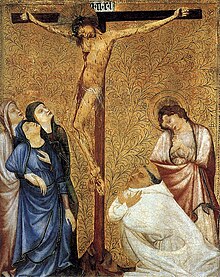
Back Cartoixa de Champmol Catalan Chartreuse de Champmol German Cartuja de Champmol Spanish Chartreuse de Champmol French Champmoli karthauzi kolostor maradványai Hungarian Chartreuse de Champmol ID Certosa di Champmol Italian シャンモル修道院 Japanese Champmol Dutch ਚੈਂਪਮੋਲ Punjabi



The Chartreuse de Champmol, formally the Chartreuse de la Sainte-Trinité de Champmol, was a Carthusian monastery on the outskirts of Dijon, which is now in France, but in the 15th century was the capital of the Duchy of Burgundy. The monastery was founded in 1383 by Duke Philip the Bold to provide a dynastic burial place for the Valois Dukes of Burgundy,[2] and operated until it was dissolved in 1791, during the French Revolution.
Called "the grandest project in a reign renowned for extravagance",[3] it was lavishly enriched with works of art, and the dispersed remnants of its collection remain key to the understanding of the art of the period.[4]
- ^ Drawing by the architect Aimé Piron, afterwards engraved (Bibliothèque municipale, Dijon).
- ^ Vaughan, 202
- ^ Sherry C. M. Lindquist, "Accounting for the Status of Artists at the Chartreuse de Champmol" Gesta 41.1, "Artistic Identity in the Late Middle Ages" (2002:15-28 p. 15)
- ^ Some works formerly at Champmol and documentation, were assembled for the exhibition "Chartreuse de Champmol", Dijon, 1960, with a catalogue containing essays by scholars of the calibre of Millard Meiss and Colin Eisler.
© MMXXIII Rich X Search. We shall prevail. All rights reserved. Rich X Search